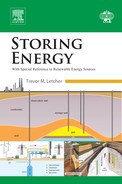Power-to-Gas
Abstract
The increased integration of intermittent renewable energy sources such as wind and solar power is a growing challenge to the new flexible model of energy production. This integration has led to the development and promotion of energy storage systems with new long-term storage options such as power-to-gas. Power-to-gas refers to the chemical storage of electrical energy in the form of gaseous substances such as methane or hydrogen. In the chapter the term “power-to-gas” is defined as the utilization of (surplus) electrical energy from renewable power sources for the production of hydrogen in an electrolyzer and the optional synthesis of methane or other hydrocarbons from hydrogen and carbon dioxide. Power-to-gas technology makes long-term storage of electrical energy possible and makes for a more resource-efficient and flexible energy system. Other long-term energy storage technologies are currently nonexistent in national grids. Power-to-gas enables accelerated integration and continued realization of low- or zero-emission technologies such as wind power and photovoltaics, thereby promoting the achievement of both climate and energy policy objectives. Furthermore, power-to-gas allows new options in energy transport by shifting load from the power grid to the gas grid. This also reduces socioeconomic challenges such as social opposition to power grid expansions. The chapter describes the power-to-gas system, in general, and deals with multifunctional applications of the technology, in particular. Another focus is on underground storage of hydrogen (see also chapter: Energy Storage Integration).
Keywords
1. Introduction

AEC, alkaline electrolyzer; PEMEC, proton exchange membrane electrolyzer; SOEC, solid oxide. (Source: Reiter [2].)

2. Dynamic electrolyzer as a core part of power- to-gas plants
Table 18.1
Typical Characteristics of Alkaline and PEM Electrolyzers
| AEC | PEMEC | |
| Available nominal power/MWel | Several | Up to 1 |
| Performance range/% | 20–100 of the available nominal power | 0–100 of the available nominal power |
| Operating pressure/105 Pa (bar) | 1–30 | Up to 100 |
| Operating temperature/°C | 60–90 | ∼80 |
| Duration/a (years) | 10–20 | 6–15 |
| Space requirement | PEMEC are by a factor of 5–10 smaller than AEC |
Source: Tichler et al. [3], based on information from Ursua et al. [9], Smolinka et al. [10], and Maclay et al. [15].
3. Methanation processes within power-to-gas

Table 18.2
Parameters of CO2 Methanation
| CO2 Methanation | |
| Performance range/% | 80–110 of the available nominal power |
| Operating pressure/105 Pa (bar) | 6–8 |
| Operating temperature/°C | 180–350 |
| Efficiency/% | 70–85 |
| Space requirement | Depending on the plant size, a doubling of capacity is not accompanied by a double space requirement |
| Development status | Demonstration stage |
Source: Tichler et al. [3], based on information from Sterner [6], Breyer et al. [22] and Cover et al. [28].
4. Multifunctional applications of the power- to-gas system
5. Underground gas storage in the context of power-to-gas

The figures relate to 109 m3 (billion cubic meters). (Source: own figure based on information in Ref. [33].)

CAES, compressed air energy storage; PHS, pumped hydroelectric storage, H2; SNG, underground gas storage of hydrogen or synthetic natural gas. (Source: own figure based on information in Ref. [34].)
